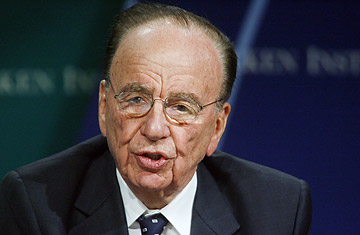
Rupert Murdoch, chairman and CEO of News Corporation.
Only a month ago, investor Sam Zell acquired effective control of the Tribune company — owner of such venerable papers as the Los Angeles Times and the Chicago Tribune — for not much more than the value of the company's landmark headquarters. After that debacle, Murdoch's cash-on-the-barrel offer of roughly $25 above the Dow Jones share price seemed to spell the end of a nightmare.
But not so fast.
For several reasons, this deal may be one of a kind. First, there is the perfect fit of the Journal and Dow Jones brands into the next big venture for Murdoch's News Corp. Having built Fox News into a 24-hour cable news giant, Murdoch is moving into the business news sector, challenging CNBC. The content, expertise and reputation of the Dow Jones properties — including Barron's and the various global Wall Street Journal editions — give him instant muscle for that fight.
Beyond that, the Journal is not like other newspapers. About the only thing it has in common with your metro daily is the paper they're printed on. Where most newspapers make their money by aggregating mass audiences to read grocery, automobile and classified ads, the Journal's business is built on an elite audience that highly values the information the paper provides. This audience in turns attracts advertising for luxury goods and financial services unavailable to most other dailies.
The evidence is growing that this is exactly the right place for a newspaper to be. As circulation for most papers continues to fall, the Journal's is growing. Last month's figures from the Audit Bureau of Circulation showed that the Journal posted another increase on top of its robust 2006 gains, to 1,721,694 subscribers.
Perhaps most important of all, the Journal is light-years ahead of other newspapers in training its readers to value information on the Internet. The Wall Street Journal Online was the first major news site to charge for access, and it remains by far the most successful pay-for-news operation, with nearly 800,000 subscribers.
And because the Journal has an elite, well-trained audience, it is able to target its coverage more efficiently than the many newspapers that find themselves chasing an ever-more atomized audience into far-flung suburbs. The news-gathering staff of the Journal numbers around 600 — roughly half the size of the New York Times.
So why has the Dow Jones stock price languished? It's a long story. The company took a well-deserved hammering for its failure to dominate the desktop analysis business, opening the door for Michael Bloomberg. That fiasco had no sooner passed into history than the entire newspaper sector began to sag. Dow Jones hasn't had a fair shot in years to show how strong its core business might become.
Until now.
